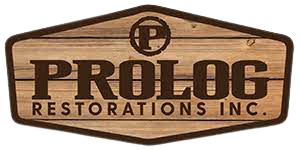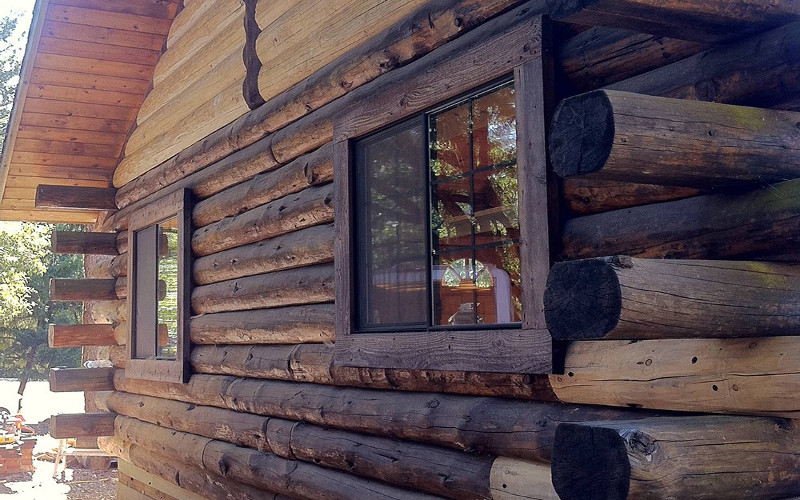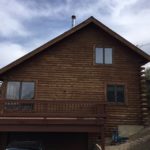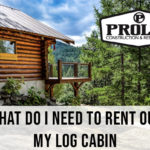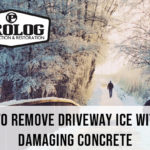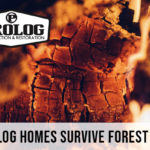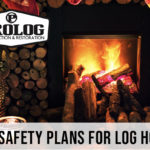Regular log home maintenance is critical for keeping your home or getaway cabin in top shape, while also keeping your upkeep and expenses down. We’ve been helping log home owners throughout California and the Western states keep their log homes looking great and in great shape for more than 30 years. To help you stay on top of your log home’s health, we’ve gathered 10 of the most important log home maintenance tips and shared them below. You don’t need a professional’s toolbox to do this, just a keen eye and the list we’ve provided here. Many things you can address on your own, but if you find any extensive damage or aren’t sure about what you see, give our professionals here at ProLog Restorations a call at 877-477-6564 and we’ll be happy to help.
Log Home Maintenance Tips
1. Annual exterior cleaning: A yearly exterior wash is an essential part of maintaining your log home or structure that will help to extend the life of both the logs and the stains and sealants you’ve applied. Washing removes surface contaminants such as dirt, mold, mildew, cobwebs, pollen and bird droppings that will wear the finish prematurely. Washing also gives you a great opportunity to be proactive in finding any potential problems that need attention like failed caulking or chinking, insect damage or dry rot. If you are thinking of applying a new coat of stain or sealant, washing the cabin beforehand will help the application last longer.
2. Mold and mildew watch: If you catch it early and determine the cause, you can often wipe out things like mold and mildew quickly. Some possible causes include sprinklers that spray directly on the logs, leaking gutters (or no gutters at all), splashing from downspouts, landscaping greenery placed too close to the house, and areas with very high humidity. Address signs of mold or mildew by adjusting sprinklers or other sources of water that could be the cause. Be sure to have gutters installed that keep water from running down the logs. Trim back your greenery to give the house at least 18 inches of breathing room.
3. Check for insects: Signs that insects such as carpenter ants, termites, carpenter bees, or beetles have moved in include irregular sized holes that are concentrated close together, small piles of sawdust, or seeing the actual insects themselves. For tips to help keep insects away, check this article: “How to Keep Bugs Out of Your Home.”
4. Chinking and caulking: The stuff between the logs that fills in the gaps caused by shrinkage or movement is called chinking or caulking. Sometimes you’ll see this coming loose or peeling off. You can try to fix it yourself by removing the chinking, cleaning the area thoroughly and then reapplying it. You may need to install a backer rod, which will help with adhesion and keep the chinking from tearing. If you’re not sure what you’re doing, check with a log home professional for guidance.
5. Stain and seal: Stain can peel, fade and wear off with time and exposure and will need to be reapplied as needed to keep your log cabin protected. Be sure to apply stain to logs that have been cleaned with a power washer to minimize potential for peeling and accelerated wear-and-tear. Use only stains that are created specifically for log cabin exteriors. You should re-stain or touch up your log home about every three years.
6. Winter roof check: If your log home is in a climate that gets lots of snow and ice for the winter, check for ice dams. These are thick ridges of solid ice that build up along the eaves. Dams can tear off gutters, loosen shingles, and cause water to back up and pour into your house. Also check for loose or damaged shingles, raised nails, leaky gutters/downspouts, clogged gutters/downspouts and white, powdery stains which are a sign of moisture infiltration.
7. Landscaping: For a healthy log home, trimming landscaping such as shrubs, bushes, and trees near your home is a must. If bushes or shrubs are too close to the house, they will trap moisture and prevent proper air circulation. In damp conditions, mold will grow on the logs. Excess moisture held in by these shrubs also accelerates the rate at which the logs rot. Plus they limit visibility, making it hard to identify potential problems and deal with them before they cause too much damage.
8. Cracks or checks in logs: Small cracks throughout your log walls are also known as “checks” and they occur naturally in wood as it ages. Small checks, which are cracks that do not go all the way through the diameter of the logs, are natural and not a cause for worry. They do not hurt the structural integrity of log homes. Larger checks and cracks, also called “spits,” are more severe and often pass through the diameter of the log making them structurally unsound.
9. Winterize outdoor faucets: Harsh winter weather can easily damage outdoor faucets and fixtures such as hose bibs. One of the easiest ways to insulate outdoor faucets is by installing frost-free hose bib faucet covers on each outdoor fixture. Hose bib covers are square or dome-shaped devices made to fit over and around outdoor faucets. They are made of thick foam which makes them very effective at keeping much of the cold away from the valve. For outdoor faucets that cannot be drained during the winter, extra insulation can be installed inside the hose bib cover to keep it warm and dry throughout the winter.
10. Annual maintenance: One of the biggest mistakes we see owners of log homes or log cabins make is to ignore these important maintenance tasks. If you own a log home be sure to mark your calendar for seasonal inspections. Regular checks for damage, insects, and all the little issues that can often be handled on your own will help prevent restoration and repair nightmares in the future. For easy maintenance guidelines and checklists, be sure to download the free ebook from our website at prologrestoration.com. The tips and tricks for creating a low maintenance log home you’ll find in our book will help save a vast amount of time, money, and effort, leaving you with plenty of space to relax and enjoy your home.
Many of the log home maintenance tips we talk about here you can address on your own, but if you find any extensive damage or aren’t sure about what you see, contact our professionals here at ProLog Restorations (877-477-6564) and we’ll be happy to help. We’ve specialized in log home staining,log home repairs and log home restoration for over 20 years and have the knowledge, equipment and experience to help you make sure your home stays strong and looks great!
